
Marrakech may only be 3 hours by plane from London, but it feels a world away. The cosmopolitan North African city is a vibrant hub of colour and print, bustling souks, and awe-inspiring Islamic architecture, in stark contrast to the usual grey concrete of the average Western city. It's an assault on the senses - the calls of sellers in the medina tussling with the rich aromas wafting from the spice markets, and deep red hues of the meandering alleyways and backstreets in the old town.
Though not the easiest place to visit, it richly rewards those who take the time to discover the beat of the city. Get used to the calls of local merchants, sharpen your haggling skills, and learn to find your way around the maze of paths, and you'll find it hard not to fall in love with the vibrancy of Marrakech.
I've visited Marrakech three times over the years, and each time, it's felt like a completely new experience. It can be frustrating, overwhelming, but there's something that keeps drawing me back. The sheer number of beautiful corners to be discovered, perhaps, which make my job as as a photographer very easy. Or the hospitality shown in the city's many charming Riads, making it one of the most comfortable cities in the world to stay well.
It's short distance from Europe makes Marrakech ideal as a mini city break destination. There's no jetlag, and it's compact enough to thoroughly cover in a couple of days. I've put together this Marrakech travel guide to share some of my favourite places, spaces, and top tips for your Marrakech adventures.

The Marrakech Travel Guide
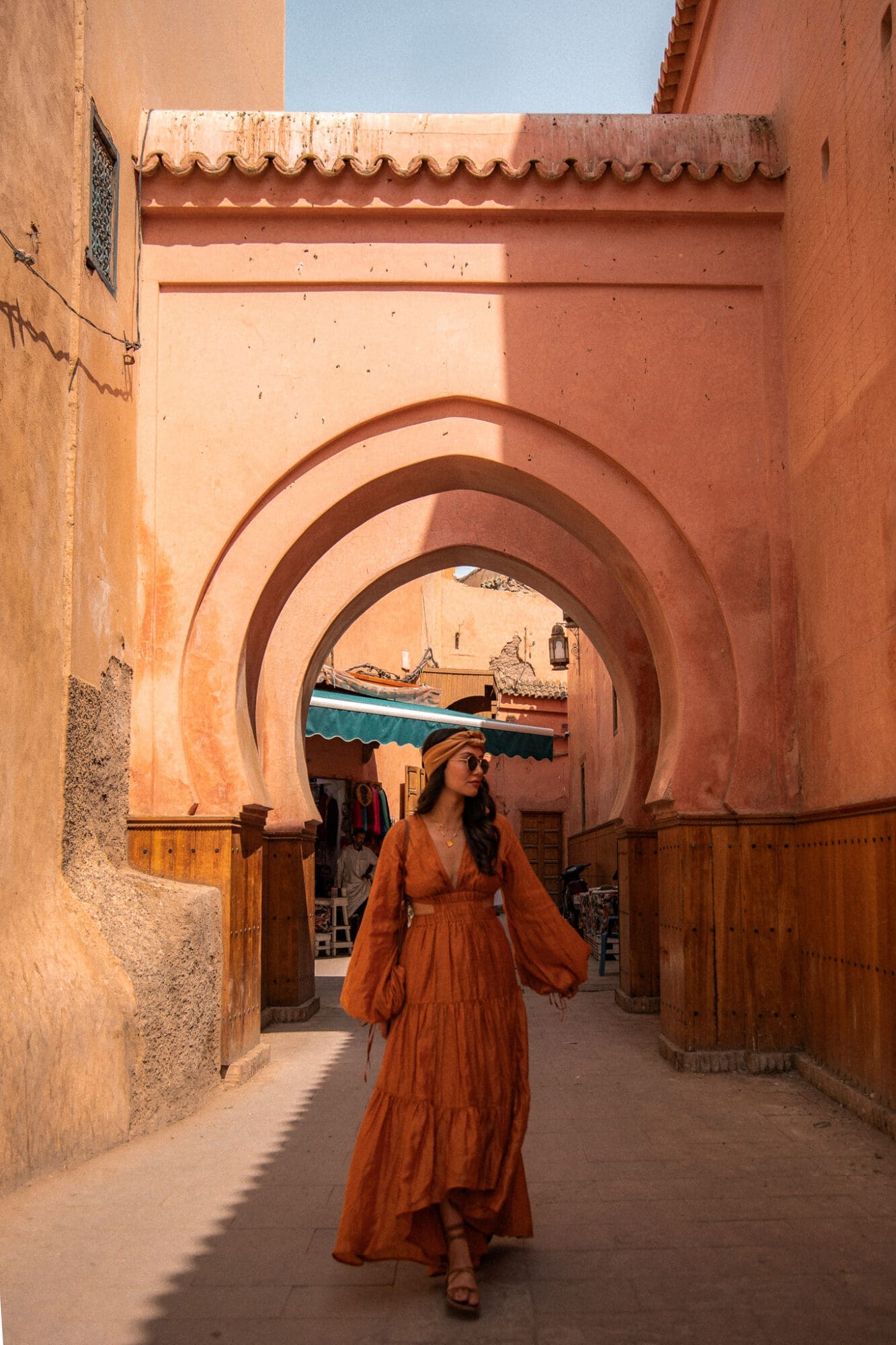

Marrakech 101
Money and Currency in Marrakech: The currency in Morocco is the Dirham, which at time of writing is roughly 12.75 Dirham to the Pound. Cash is king, so don't expect to rely on card. I'd recommend taking money to change. Moroccan Dirham is a closed currency, so can't be purchased in advance.
Language in Marrakech: In Marrakech many of the people you interact with will speak English, especially in the touristy areas. French is also useful, and you’ll also hear Arabic and Berber. The main phrase you'll need is "La Shukran", which means no thank you!
Internet in Marrakech: Wifi is fairly widespread or you can pick up a cheap local SIM when you arrive. We purchased E-Sims in advance of our trip, which cost around £6-£7 for one GB of data for 7 days.
Visiting Marrakech as a female traveller: I’ve been to the city three times now, as it feeds my love of colour, vibrancy, and maximalism. However its definitely somewhere I recommend approaching with some caution as a female traveller. It's a Muslim country so I'd recommend covering up, however you may still receive a lot of hassle. I've visited previously with two other women, and we received a fair amount of unwanted and at times unpleasant attention. Personally I've found you're far less likely to be bothered if you travel with male companions.
Shopping in Marrakech: Haggling is the norm in the souks, which can be majorly frustrating but also so satisfying when you nab a great bargain. I usually aim for half the price they say, and if they’re not going down start walking away – they’ll usually call you back and agree to your price.
How to get around Marrakech: Like many cities, there is a new town and an old town. The old town is the main spot for all the tourist sights, other than the Yves Saint Laurent gardens which are just outside of town. The airport is a quick taxi ride away, maybe 20 minutes from most parts of the old town. In theory taxis are metered, but in practise most will try and make you pay a fixed fare. However, most of the city is walkable. Stay on the right to avoid the motorbikes and scooters, which can make walking quite hairy at times.
Where to stay in Marrakech: If you want to be within walking distance of the main sights, I'd recommend staying within the confines of the old town walls. One of the main questions you'll find yourself asking, is whether to stay in a riad or a hotel in Marrakech. Personally I'd recommend experiencing a riad at least once, as it's such a uniquely Moroccan experience.
What to Wear in Marrakech
It’s a very tourist friendly city so whilst the local women dress modestly, they’re fairly used to seeing Western dress. Therefore you don’t need to be completely covered. I opted for below the knee midi and maxi dresses, and covering shoulders with a light shawl. However there were tourists in shorts and tank tops, and I did wear a couple of strappier dresses for dinners out and didn’t get any more attention than I was receiving previously. Carry a shawl around with you as you may need to cover up for certain sights such as religious buildings. Read my guide for more practical advice on what to wear in Morocco as a female traveller.

Shop My Marrakech Picks

Wear to Stay in Marrakech
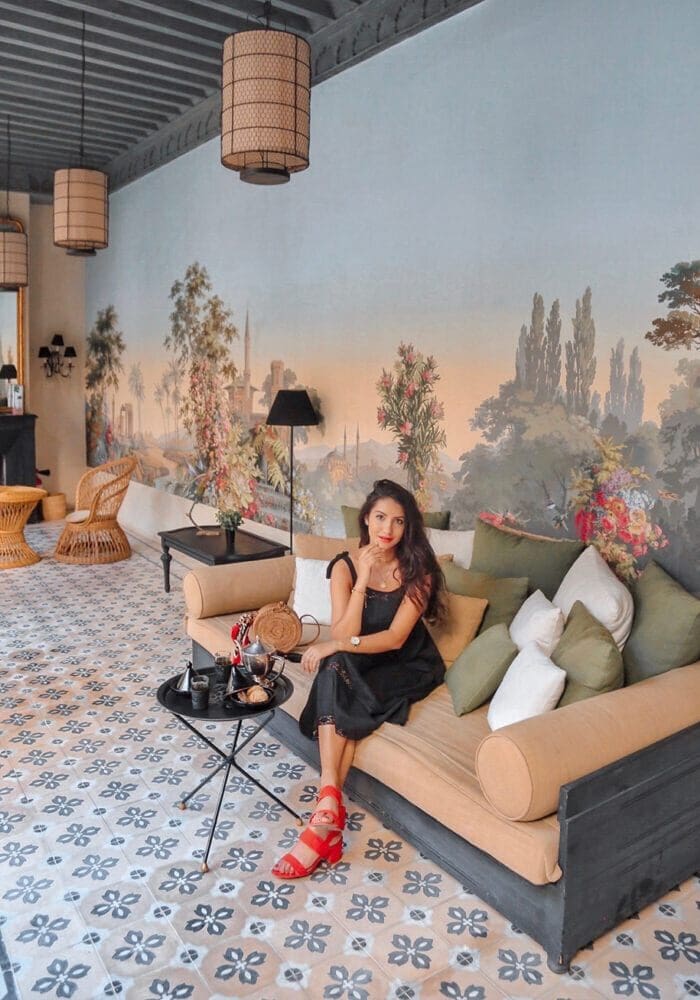


Riad Tarabel
In the heart of the Old Town not far from the Medina, Riad Tarabel is nestled in a side street almost impossible to find unless you know what you’re looking for. But that’s part of it’s charm – it’s a secret oasis hidden away from the hustle and bustle of the city.
At the heart of the Riad is the courtyard, framed by tropical plants and seating areas surrounding a pool. But there’s more to explore, with tucked away lounge areas and a rooftop to relax under the Moroccan sun. What sets Tarabel apart is the distinctiveness of the decor, combining traditional touches with a pared back French aesthetic. There isn’t a hint of kitsch or pastiche; the elements of Moroccan design woven in through the architecture and furniture are subtle and elegant, paired with a clean colour palette and refined decorative details with a hint of nostalgia.
Marrakech can be loud, intense, and overwhelming, but Riad Tarabel is a breath of fresh air within it. It’s tranquility and quiet charm make it a perfect location to refresh and recharge after a day out on the streets.
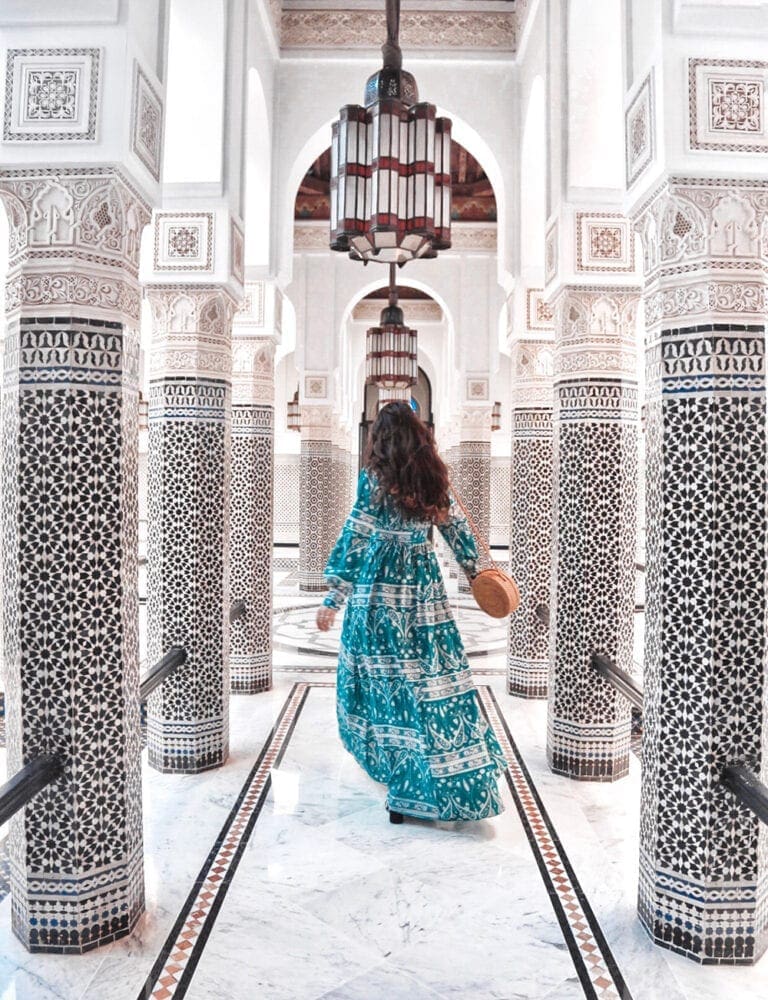
Hotel Mamounia
Whether you’re staying there or not, you’ll probably make a trip to the breathtaking Mamounia, a luxury 5-star hotel set in a former royal palace. It’s a rambling estate with several bars, restaurants, and acres of grounds including an outdoor pool. Whilst I can’t comment on the experience of staying (sadly it’s slightly outside my budget!), it’s a real Marrakech highlight and feels like into a glimpse of a different world. Take the time to stroll around the grounds and seek out the different nooks and crannies that make the hotel so special, from hidden bars to a small bakery packed with sweet treats. Plus if you’re looking for gram-worthy spots, you’ll find plenty of #InstaGold, including the Instagram famous monochrome pillars.

Things to do in Marrakech



Medersa Ben Youssef
Medersa Ben Youssef is a 14th century religious school. The largest in North Africa, it's a UNESCO World Heritage Site, and a striking example of Islamic architecture. The main complex is housed around a breathtaking open courtyard, with high tiled walls surrounding a gentle water feature. Head up the stairs to discover a maze of rooms overlooking the courtyard below. This was personally one of my favourite of the things to do in Marrakech - it's a lovely respite from the bustle of the streets!
The Medersa is open to the public from 9am to 8pm, and costs 50 dirhams for adult (non-resident) tickets. I'd recommend visiting at opening or just before closing time if possible to avoid the crowds.
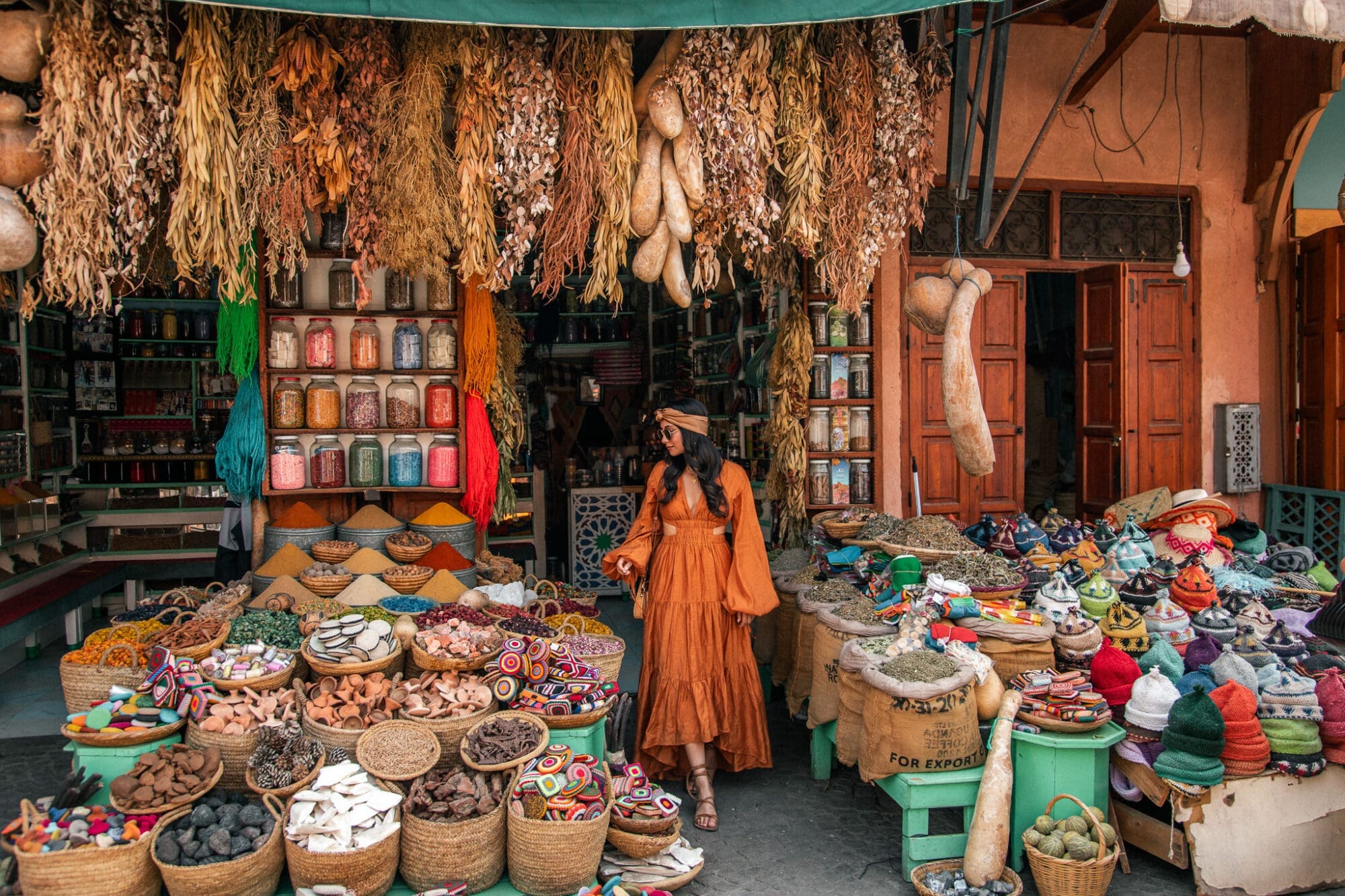


The Souks
If there's one thing Marrakech is great for, it's shopping. The city is famous for it's souks, sprawling covered markets selling everything from local artisan products and homeware, to designer knockoffs and replica shirts aplenty. The main souks start around the Jemaa el-Fnaa and sprawl northwards, however there are stalls spread throughout the old town. The stalls usually open from around 10am, to 8 or 9pm at night.
It's a lot of fun to explore, regardless of whether you're looking to shop or not. Some of the best things to pick up include crockery, spices, and traditional straw woven pieces such as bags and hats. Make sure to haggle (I usually aim to settle on around half to 3/4 of the price they start with). And leave yourself plenty of suitcase space!
Keep in mind some of the stalls have no photo signs. Whilst others are happy to have pictures taken, it's polite to consider buying something, or giving a small tip.



El Badi Palace
The El Badi Palace is a 16th century palace built by Sultan Ahmad al-Mansur and a magnificent showcase to the wealth and grandeur of the Saadian Dynasty. The palace is now largely in ruins, although there are still some examples of Moroccan tilework on display. Some rooms host an exhibition featuring the history of the palace and city. It's quite text heavy, and many sections are only in Arabic and French.
At 100 dirhams entry, its quite steep for what it is. However, I enjoyed that it was relatively quieter than some of the more popular sights in the city. It's also fascinating imagining the spectacular parties that must have taken place in the central courtyard before the palace fell to ruins.



Bahia Palace
The Bahia Palace is a striking example of Moroccan architecture, featuring several grand rooms and courtyards covered in ornate tile-work. Whilst there’s no furniture and very little introduction into the history of the palace, it’s still a beautiful place to admire Moroccan craftsmanship such as the ornate detailing of painted wood ceilings and stained glass windows. Again, come early or towards closing to avoid traipsing behind tour groups!
The Saadian Tombs
Not necessarily a must-see but worth popping by if you’ve got time to kill, the Saadian Tombs is the resplendently decorated resting place of Sultans past. There’s plenty of the usual ornate tile-work in the traditional Moroccan style, however be prepared for queues and overcrowding.
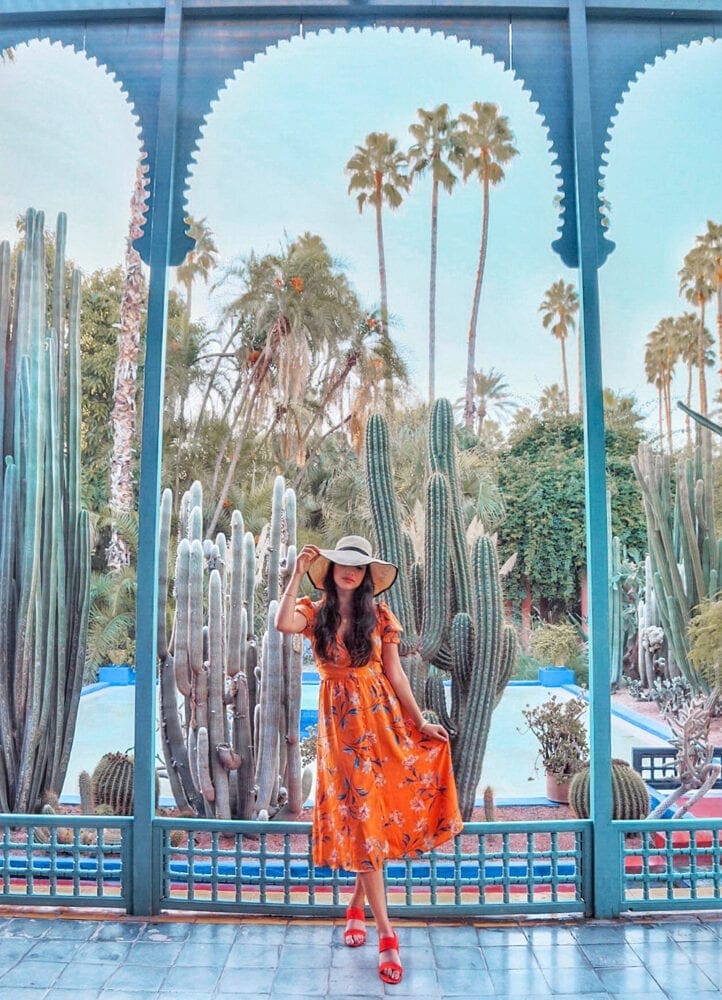
Jardin Majorelle
One of the few sights in the New Town is the Jardin Majorelle, a beautiful botanical garden previously owned by Yves Saint Laurent and housing a Museum of the late French fashion designer. It’s a fairly small complex, but well worth visiting for the striking design styles and colours on displays. I can’t comment on the range of flora and fauna as it’s not my area of expertise, but it makes for a lovely wander amongst the foliage, offering a respite from the African heat.
Top Tip: Arrive at opening to avoid the crowds (and get the best pics!)

Restaurants and Cafes in Marrakech
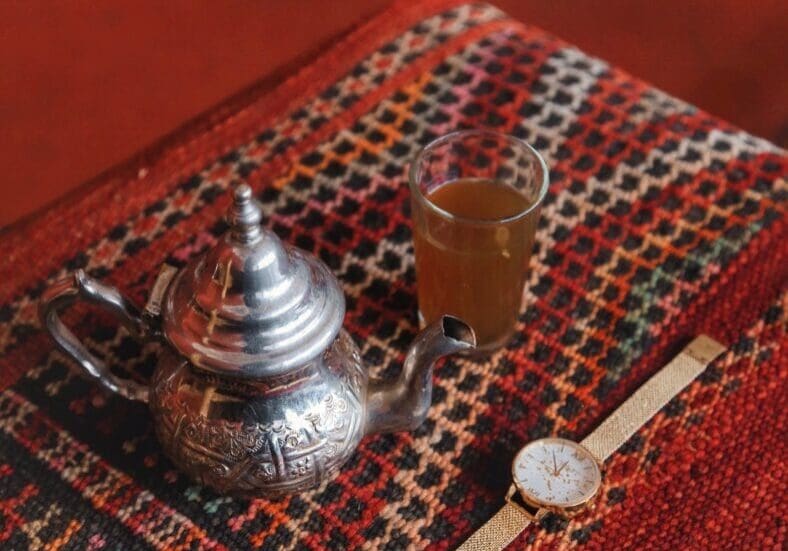
EATING AND DRINKING
If your go-to order is a sandwich and chips, Moroccan cuisine may not be for you. It’s spicy, flavourful, and often contains unexpected ingredients such as raisins and apricots. It also tends to be heavily reliant on couscous, a traditional national grain, as well as being predominantly meat-based, although more vegetarian and vegan options are becoming available.
Drinking is still not common in Morocco, however there are certain bars and hotels which serve alcohol, although prices tend to be at a premium. If you’re looking to drink, plan ahead, and keep in mind that it won’t be cheap!
Must-try Moroccan Dishes
Tagine: Most commonly served with lamb or beef and mixed vegetables, a tagine is a traditional stew cooked in an earthenware pot.
Briouats: kind of samosa, these are fried pastries filled with meat and/or cheese. A delicious snack!
Bastilla: A pastry pie filled with saffron chicken, and covered in almonds and orange flower water. A weird mix of sweet and savoury, it’s not for everyone but definitely worth trying.
Mint Tea: I’m not generally a tea drinker, but Moroccan tea might just convert me. It’s gunpowder tea with sprigs of spearmint, and is sweet and flavoursome.


Le Salama
Marrakesh holds its own when it comes to rooftop restaurants. Le Salama, in the heart of the bustling old town just off Jemaa el-Fnaa, is arguably one of the most beautiful. Spread out over three floors, the covered rooftop level offers panoramic views of the surrounding red roofs of the city. However its the interiors that really stand out, with chic modern Moroccan design details sitting pretty under a canopy of green foliage.
I popped in for a light lunch of mezze dishes, paired with happy hour aperol spritzes. Everything was light, fresh, and packed with flavour. A favourite was the cheese "cigarettes" wrapped in pastry with a sweet chilli dipping sauce. Cheese and pastry are just an elite combination. Visit at sunset and later into the evening when the restaurant really comes to life, to enjoy a traditional show as you dine.
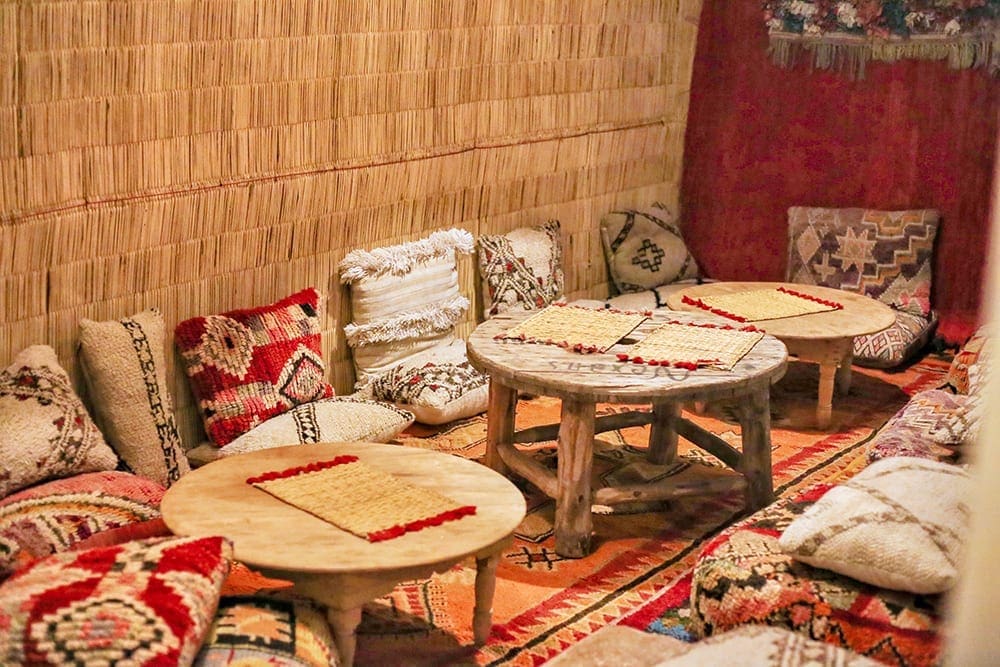
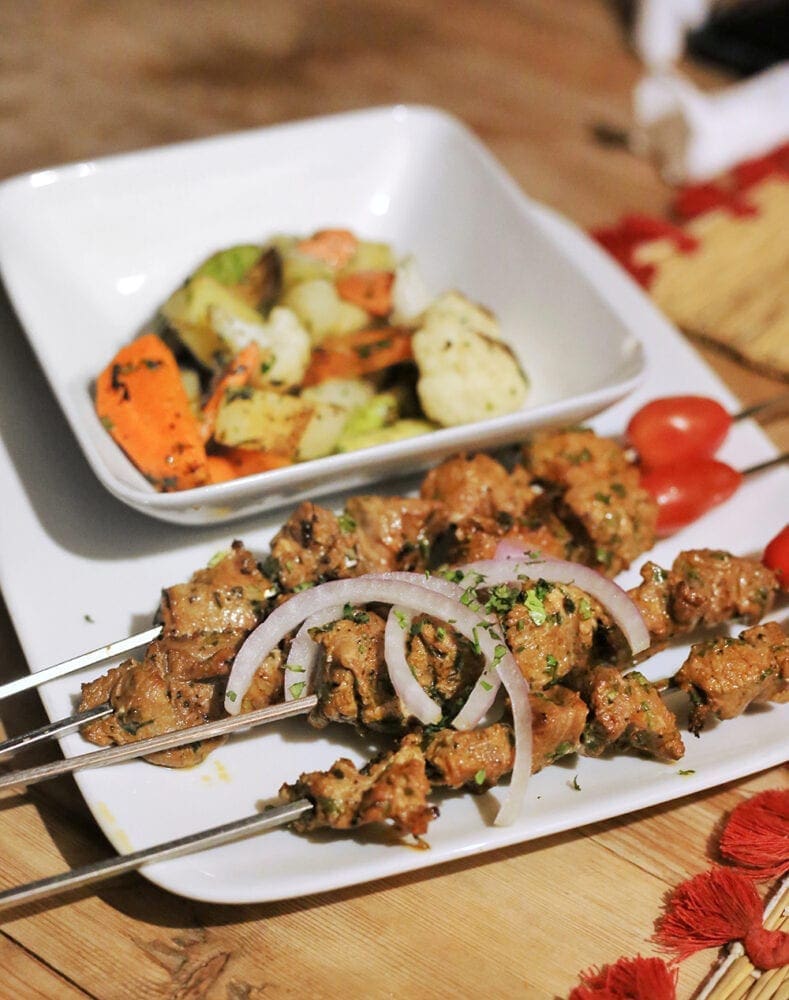
La Ferme Restaurant
One of the best meals we had on our trip was in the beautiful courtyard of La Ferme, an atmospheric spot in the centre of the Old Town. The menu is mainly traditional, but they also do pizzas and a few Asian options.
The food was really enjoyable – we went for the beef skewers and chicken rfissa (chicken served on a bed of lentils and shredded trid pastry). However the real draw is the ambience, with seating areas dotted around the space nestled between foliage. There was also live music during our meal, all of which added to the overall relaxed mood. We visited at night, however I imagine it’s a nice spot for a casual lunch during the day too. They don’t serve alcohol.
Best For: A delicious traditional meal
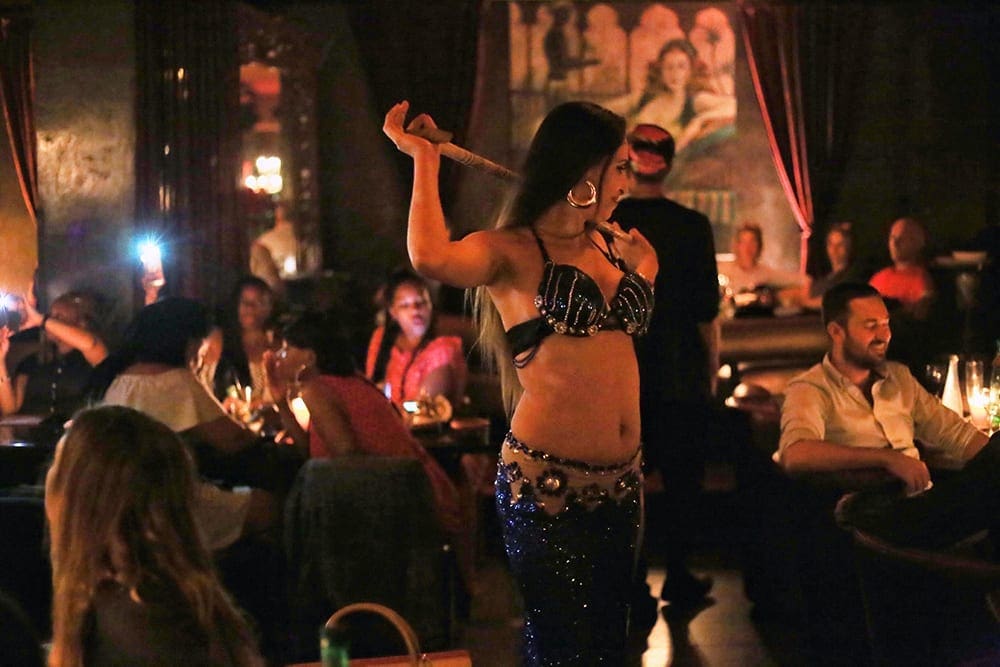
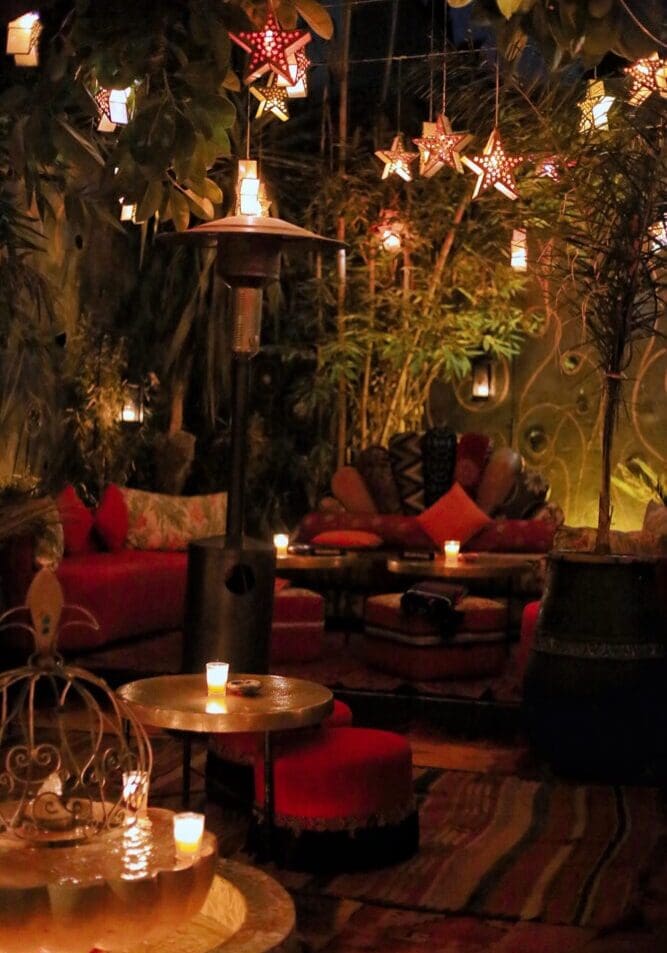

Comptoir Darna
Comptoir Darna is one of Marrakech's top spots for catching belly dancing, with shows every night. Part bar, part restaurant, part club, it's a fun nighttime spot to get dressed up for and enjoy a cocktail or two with a live show.
We headed to the terrace for an initial drink, which is a gorgeous spot filled with foliage and glowing lights - it feels like something out of a fairytale. Even better though was their amazing cocktail menu, full of exotic flavours and combinations. I tried a Spicy Souk, with vodka, tangerine liquor, cardamom and ginger, which (if the name didn't give it away) had a spicy kick to it and was lovely and warming. It tasted a bit like exotic Marrakech in a drink!
My friends also loved the Passion Lychee and Tango Mango which they tried - all so good! The cocktails range from 120-150 dirham, so £10-£12. Not cheap, but worth trying because they really are something special.
There's a few different dining areas, including the ground and first floor, and a terrace. I'd recommend booking in advance, and getting a table upstairs. It gets busy! The food menu has a range of local and international dishes - again, not cheap, but think of Comptoir as your fancy night out location! We shared the Kefta Tagine (pictured) and the Royal Couscous (couscous with mixed meats). Both delicious - maybe not quite worth the high price tag, but you're also paying for the atmosphere.
You can catch the belly dancers from 10pm every night, who dance amongst the tables to entertain diners. It's quite the spectacle, if a little...weird. Honestly, we felt a bit uncomfortable watching such an overtly sexualised performance, however everyone seemed to enjoy it. It's still amazing to watch though, with woman carrying trays of candles on their heads, and lots of gorgeous sparkly outfits. One to tick off the bucket list!
Best For: A big night out!
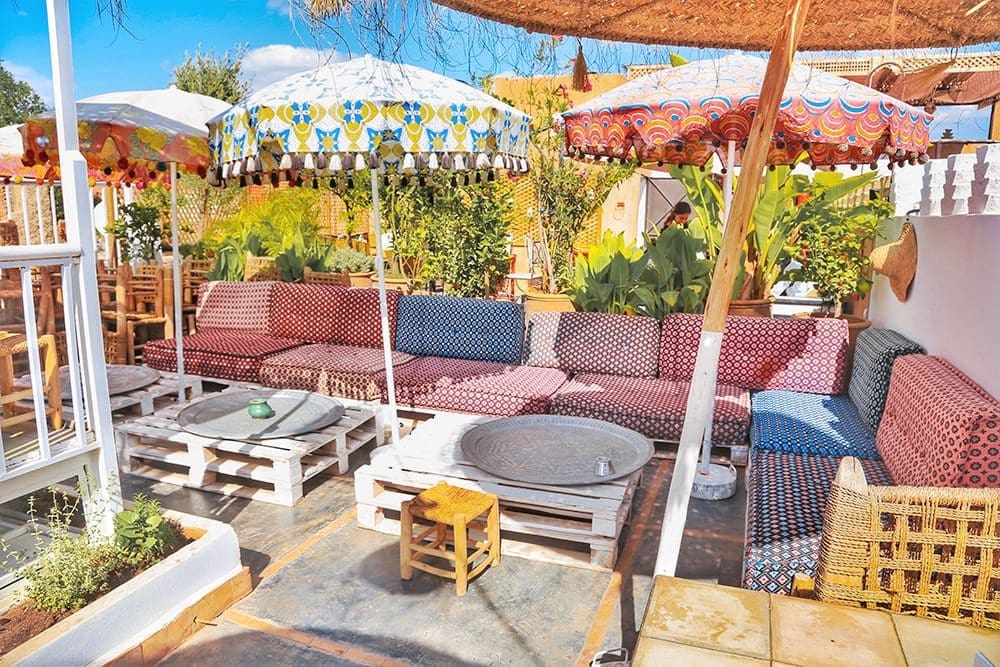
Max & Jan
We stumbled across Max & Jan when in search of a respite from the Souks, tucked away off one of the many meandering alleyways leading from the Medina. It's a concept shop and restaurant with a Western flair, paired with Moroccan design. The roof terrace is a beautiful space to relax, with cosy sofas and umbrellas to keep you shaded. We just stopped for a quick drink to refresh, but the food menu looked tasty with lots of international options (if you're getting sick of traditional cuisine!)
Best For: A laidback drink in the sun



I hope this Marrakech Travel Guide proves helpful if you're planning a trip. Give me a shout on Instagram if you check out any of these places, I'd love to hear about your experience.
Have you been to Marrakech? Let me know any other suggestions for things to do in Marrakech, and make sure to subscribe for lots more guides and tips!

Pin Me




Marrakech is a beautiful city and you wore some beautiful outfits whilst exploring it. It’s a fabulous place for photography.
I truly appreciated you providing this site, so thank you so much. Learning more about Marrakech, one of Morocco’s most important historical sites, is really pleasant. Once again, thank you; reading your post was a true pleasure. Keep up the fantastic work, please.